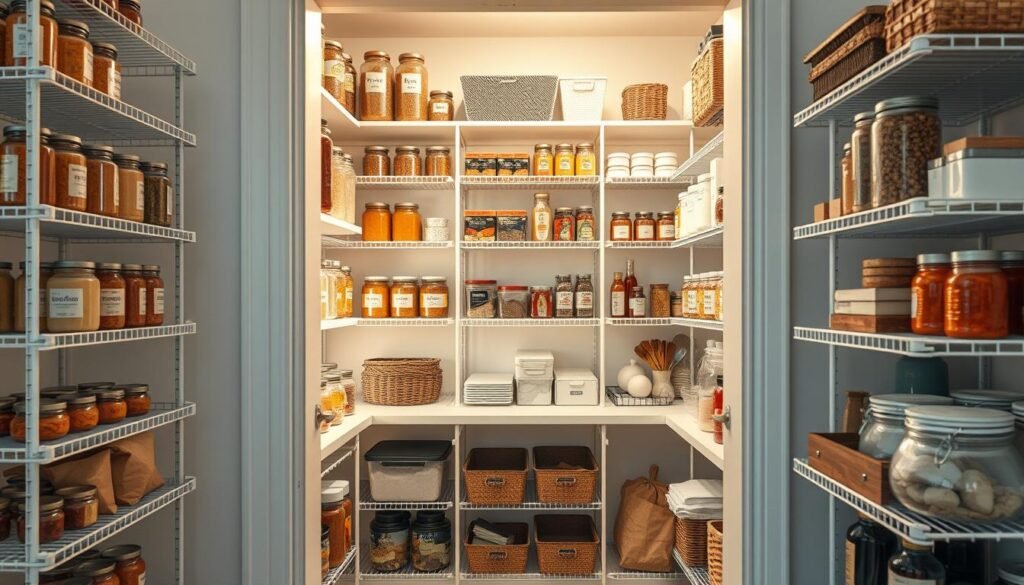
Are you tired of rummaging through a cluttered pantry only to find expired or missing items? You’re not alone. Many of us struggle with limited space in our kitchens, leading to wasted time, money, and food.
A disorganized pantry can be a significant source of frustration. Duplicate purchases and expired items are just a few consequences of poor storage and organization. The good news is that you don’t need a larger space or a costly renovation to get your kitchen in order.
With a few simple hacks, you can transform your pantry into a functional and efficient storage area. In this article, we’ll explore practical strategies for maximizing your space and keeping your food items organized and accessible.
Key Takeaways
- Simple hacks to transform your pantry into a functional storage area
- Practical strategies for maximizing pantry space
- Tips for keeping food items organized and accessible
- Benefits of a well-organized pantry for meal preparation and grocery shopping
- Solutions that work for pantries of all sizes
The Pantry Problem: Why Most Spaces Feel Cramped
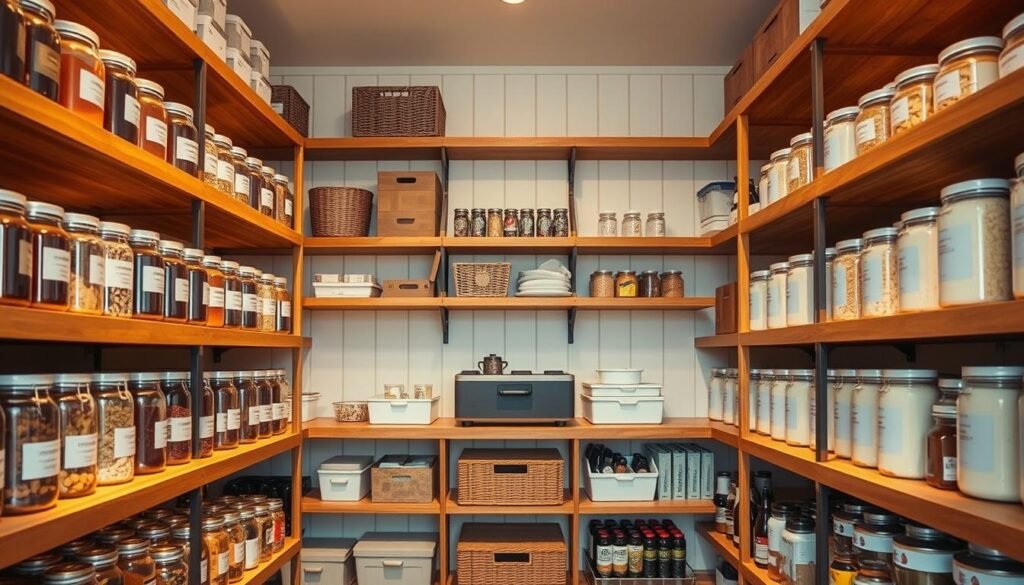
Pantries often feel like they’re bursting at the seams, but the issue isn’t always the size – it’s the organization. You might be surprised to find that the problem lies not in the pantry’s dimensions, but in how the space is utilized.
Common Pantry Pain Points
Many of us struggle with pantries that feel cluttered and disorganized. Some common issues include:
- Inefficient use of vertical space, leading to wasted storage potential
- Poor shelf spacing that makes it difficult to store items comfortably
- Lack of organizational systems, causing items to get lost in the back of deep shelves
- Difficulty finding ingredients when cooking, leading to frustration and wasted time
- Expired food discoveries due to poor visibility and inventory management
- Bulky packaging from store-bought items wastes valuable space
Benefits of an Organized Pantry System
Implementing an organized pantry system can have numerous benefits, including:
- Time savings from being able to quickly locate ingredients and cooking supplies
- Reduced food waste by keeping track of expiration dates and ensuring older items are used first
- Easier meal planning due to clear visibility of available ingredients
- Visual calm and reduced mental load during food preparation
- Avoiding impulse purchases and duplicates of items you already own
- Making a small pantry feel more spacious and a large pantry truly functional
By addressing these common pain points and implementing an organized system, you can transform your pantry into a functional and stress-free space that makes cooking and meal planning a breeze.
First Step: Declutter and Take Inventory
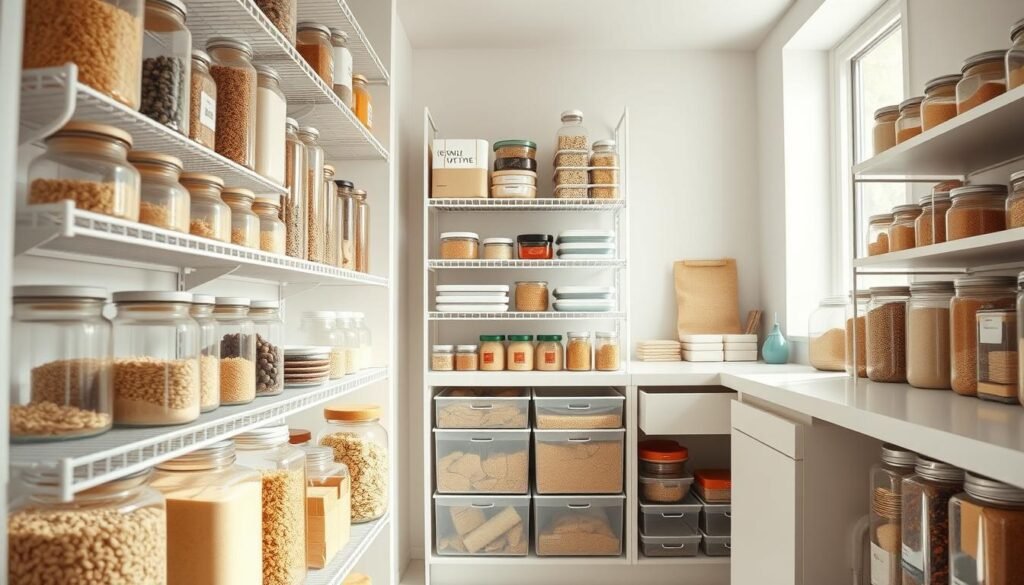
Transforming your pantry into a haven of efficiency starts with decluttering and inventory. To begin, take everything out of your pantry to start with a clean slate. This initial step is crucial because it allows you to see exactly what you’re working with.
Remove Expired Items
Start by checking expiration dates and safely disposing of expired or stale food items. Be ruthless – if it’s past its prime, it’s time to let it go. This process not only frees up space but also ensures that your pantry is stocked with fresh and safe food storage options.
Consolidate Duplicates
Next, identify and consolidate duplicate items, such as multiple open packages of the same food. Consolidating these duplicates will help reduce clutter and make the most of your pantry space.
Create a Food Inventory System
Now, create a simple food inventory system that works for your household’s needs and cooking habits. Consider categorizing your pantry items during this process to make the organization phase more efficient. You can also use this opportunity to donate unexpired, unopened food items that your family won’t use to reduce waste.
A proper inventory system will help with meal planning and grocery shopping efficiency, making it easier to keep your pantry organized and clutter-free.
Smart Ways to Maximize Pantry Space
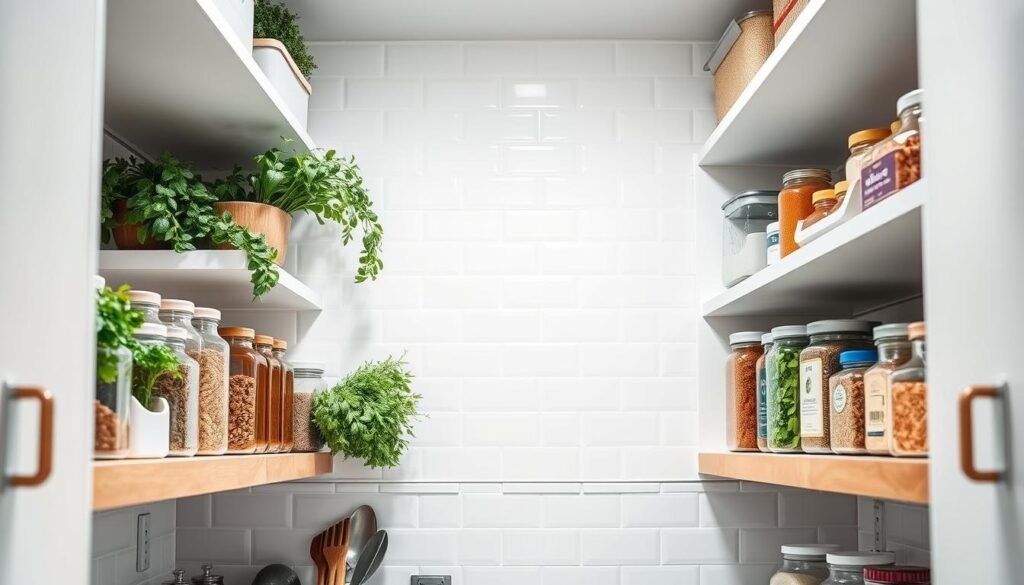
Maximizing pantry space can feel like a puzzle, but with the right strategies, you can create a more organized kitchen. To start, it’s essential to understand your pantry’s current state.
Assess Your Current Layout
Take a close look at your pantry’s layout and identify areas that feel cramped or cluttered. Consider the types of items you store and how you can optimize the space for your needs. Measure your pantry and common food items to ensure any new organization solutions fit perfectly.
Think Vertically
Utilizing your pantry’s vertical space can dramatically increase storage capacity. Think vertically by installing shelves or storage units that go up to the ceiling. This is particularly useful for storing less frequently used items, like special occasion dishes or out-of-season foods.
Consider Shelf Spacing and Depth
Adjusting shelf spacing and depth can make a significant difference in your pantry’s storage capacity. For example, taller spacing is ideal for cereal boxes and appliances, while shorter spacing is better suited for canned goods. Consider using adjustable shelving to customize your storage as your needs change.
- Optimize shelf spacing for different types of food items.
- Use adjustable shelving for customization.
- Make the most of the space between the top shelf and ceiling for seasonal or rarely used items.
By implementing these strategies, you can maximize your pantry space and create a more efficient kitchen.
Container Solutions That Create Order
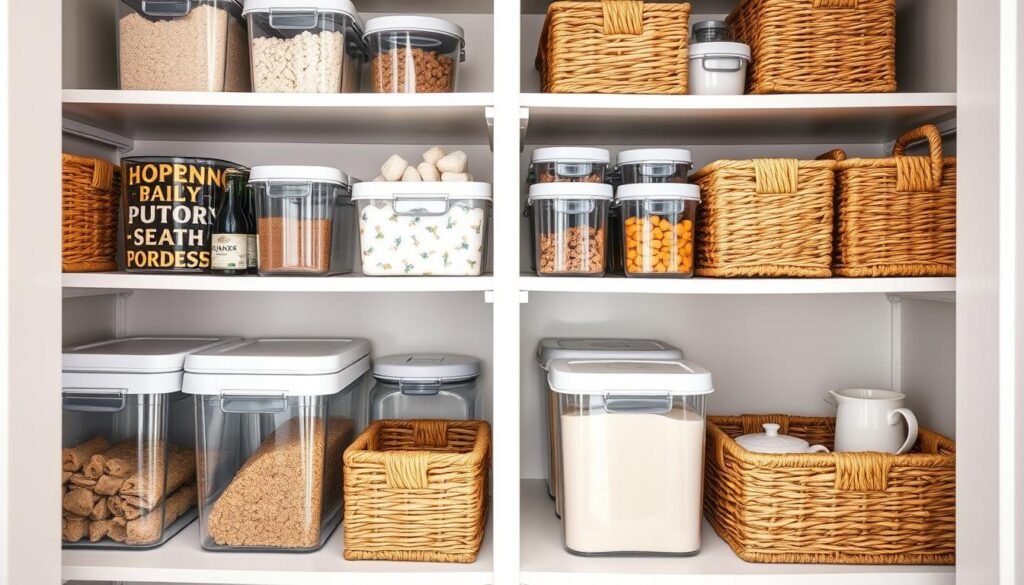
When it comes to pantry organization, the type of containers you use can make all the difference. The right storage solutions can transform your pantry into a haven of order and efficiency.
Clear Containers for Visibility
Transferring dry goods like flour, sugar, pasta, and cereal into clear, airtight containers not only keeps them fresh but also allows you to see when supplies are running low. This visibility makes grocery shopping more efficient, as you’ll know exactly what you need to restock.
Uniform Storage for Visual Calm
Using uniform storage containers creates visual calm and makes your pantry look more organized, even when it’s full. This uniformity is not just aesthetically pleasing; it also helps in maintaining the organization system you’ve put in place.
Stackable Options to Save Space
Stackable containers are a game-changer for maximizing pantry space. By utilizing vertical space efficiently, you can store more items without cluttering your shelves. Look for containers that are designed to stack securely, making the most of your storage capacity.
For different items, consider using specific types of containers. For instance, glass containers are ideal for storing items you want to keep fresh longer, while plastic containers are great for kid-accessible snacks. Decanting your dry goods into appropriate containers can prevent pest problems and extend food freshness.
Shelf Organization Strategies
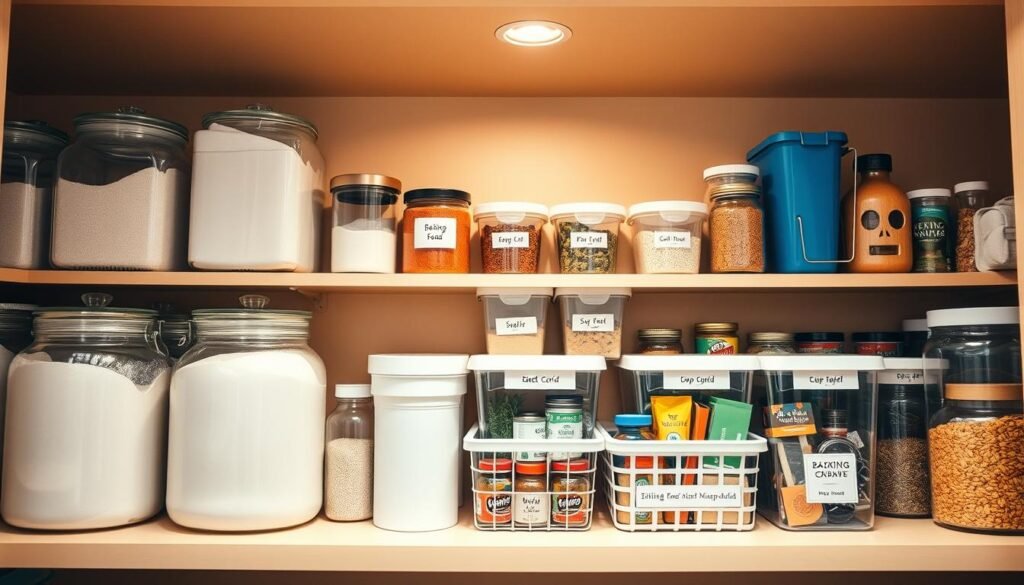
A well-organized shelf is the backbone of a clutter-free pantry. To achieve this, you need to think strategically about how you use your shelves. Start by assessing your current shelf layout and identifying areas for improvement.
Efficient Use of Vertical Space
Shelf risers and stackers can instantly double your usable shelf space by creating multiple levels on a single shelf. This is particularly useful for storing items like canned goods or bottles.
Utilizing Hidden Spaces
Under-shelf drawers and baskets are perfect for utilizing the often-wasted space between shelves. These are great for storing small items or snacks. Additionally, lazy Susans can solve the problem of inaccessible corner spaces and deep shelves by bringing items to the front with a simple spin.
By implementing these storage solutions, you can create a custom organization system tailored to your specific pantry needs.
Door and Wall Storage Solutions
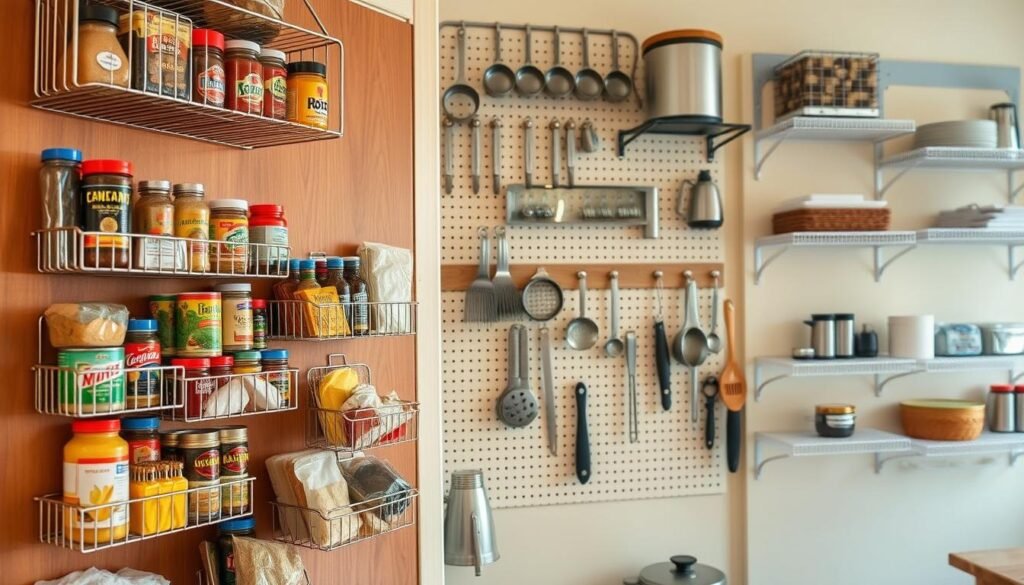
Your pantry doors and walls hold a secret to extra storage space that can revolutionize your kitchen organization. By utilizing over-the-door organizers and wall-mounted storage solutions, you can significantly enhance your pantry’s functionality.
Over-the-Door Organizers
Over-the-door organizers are a game-changer for pantry storage. They come in various forms, including pocket organizers for storing snacks or spices, hanging racks for utensils or bags, and adjustable systems that can be customized to fit your needs. These organizers are perfect for storing lightweight, frequently used items, keeping them within easy reach.
Wall-Mounted Baskets and Hooks
Wall-mounted baskets and hooks can transform empty wall space into functional storage. Use baskets for storing fruits, vegetables, or snacks, and hooks for hanging aprons, bags, or utensils. This not only adds storage but also keeps your pantry floor clear, making it easier to navigate.
Spice Racks and Slim Storage
For narrow spaces between shelves or along walls, consider slim storage solutions like spice racks. These are ideal for storing spices, oils, or condiments, keeping them organized and easily accessible. When choosing wall storage, consider the weight and size of the items you plan to store to ensure the solution is appropriate.
When implementing door and wall storage solutions, it’s crucial to choose organizers that won’t interfere with the door’s ability to close properly. Categorizing items stored on doors and walls can also enhance accessibility during meal preparation. For renters, consider adhesive or removable solutions to avoid damaging the doors or walls.
Floor Space: The Overlooked Storage Area

The floor of your pantry is more than just a place to stand; it’s a storage opportunity waiting to be seized. By utilizing this often-overlooked space, you can significantly enhance your pantry’s overall storage capacity.
Large Baskets for Bulk Items
Using large baskets on the pantry floor can help corral bulk purchases, pet food, or backup supplies, keeping them organized and out of the way. This approach not only keeps the floor tidy but also makes it easier to access what you need.
Appliance Storage Solutions
Strategic appliance storage on the pantry floor is perfect for items not used daily, such as slow cookers, bread makers, or specialty cooking tools. By storing these items on the floor, you free up valuable shelf space for more frequently used items.
Rolling Carts and Shelves
Rolling carts and shelves provide flexible, movable storage that can be easily rearranged as your needs change. These are particularly useful in the pantry, allowing you to maximize floor space while maintaining easy access to stored items.
To maximize floor space without creating clutter, consider using stackable storage bins. These bins utilize vertical space while keeping categories separate, making it easier to find what you need. Regular maintenance, such as cleaning and checking for pests, is also crucial to keep your floor storage area organized and pest-free.
By thoughtfully organizing your pantry’s floor space, you can create a more functional and visually appealing storage system that enhances your overall pantry organization.
Creating Functional Zones in Your Pantry
Transforming your pantry into a highly functional space starts with creating distinct zones for different activities. By grouping similar items together, you’ll not only improve the aesthetic of your pantry but also enhance its efficiency and organization.
Let’s explore how to create these zones effectively. A well-designed pantry typically includes areas dedicated to specific tasks or categories of food. For instance, a baking station can be a game-changer for avid bakers. This zone can house all your baking essentials like flour, sugar, baking powder, and other staples in one convenient location.
Baking Station
To set up a baking station, consider using clear, stackable containers to store your ingredients. Labeling these containers can further enhance the functionality of this zone. For example, you can use airtight bins for flour and sugar to keep them fresh and easily accessible.
Snack Zone
A snack zone is another valuable addition, especially for families with kids. This area can be designed to be easily accessible, perhaps at a lower level, and can include a variety of healthy snack options. Using baskets or bins with labels can help keep this zone organized and make it simple for everyone to find what they’re looking for.
Meal Prep Area
For those who enjoy cooking, a meal prep area can be incredibly useful. This zone can be stocked with commonly used dinner ingredients, making weeknight cooking a breeze. Consider organizing your canned goods, spices, and cooking oils in this area for maximum efficiency.
When designing your pantry zones, think about your family’s eating habits and adjust accordingly. You might also consider a breakfast zone, lunch packing station, or areas for special diets. Positioning these zones based on usage frequency is key – place your most used items at eye level and less frequently used items higher or lower.
Zones can also aid in inventory management and grocery shopping by making it clear when supplies are running low. To visually distinguish between zones, you can use different container types or implement a color-coding system. This not only adds a touch of personality to your pantry but also makes navigation a snap.
| Zone | Purpose | Storage Ideas |
|---|---|---|
| Baking Station | Store baking essentials | Clear containers, airtight bins |
| Snack Zone | Easily accessible snacks | Baskets, labeled bins |
| Meal Prep Area | Organize dinner ingredients | Canned goods shelves, spice racks |
By implementing these zones and tailoring them to your needs, you’ll not only have a more organized pantry but also a more efficient cooking process. So, take the first step today and start zoning your way to a more functional pantry!
Kid-Friendly Pantry Organization
Organizing your pantry with kids in mind can be a game-changer for family mealtime and snack routines. By creating a space that’s both accessible and fun, you’re not just tidying up – you’re teaching your kids valuable life skills.
Accessible Snack Solutions
Setting up snack stations at a lower height allows kids to help themselves, promoting independence. Using clear containers and baskets enables them to see what’s available without rummaging through the pantry. Consider portion-controlled snack solutions to maintain oversight while giving kids the freedom to choose.
Color-Coding for Easy Navigation
A color-coding system can be a simple yet effective way to help kids identify where items belong and where to find their favorites. This visual system works even for non-readers, making it an inclusive solution for children of all ages.
Teaching Independence Through Organization
Involving your kids in the organization process not only teaches them about responsibility but also helps them understand the system they’ve helped create. By making the pantry kid-friendly, you’re encouraging them to take ownership of their snack time and meal prep, reducing your workload in the process.
When designing a kid-friendly pantry, safety should be a top consideration. Avoid using glass containers in kid zones, opting instead for durable, easy-to-clean materials. With a little creativity, you can create a pantry that’s both fun and functional for the whole family.
Labeling Systems That Work
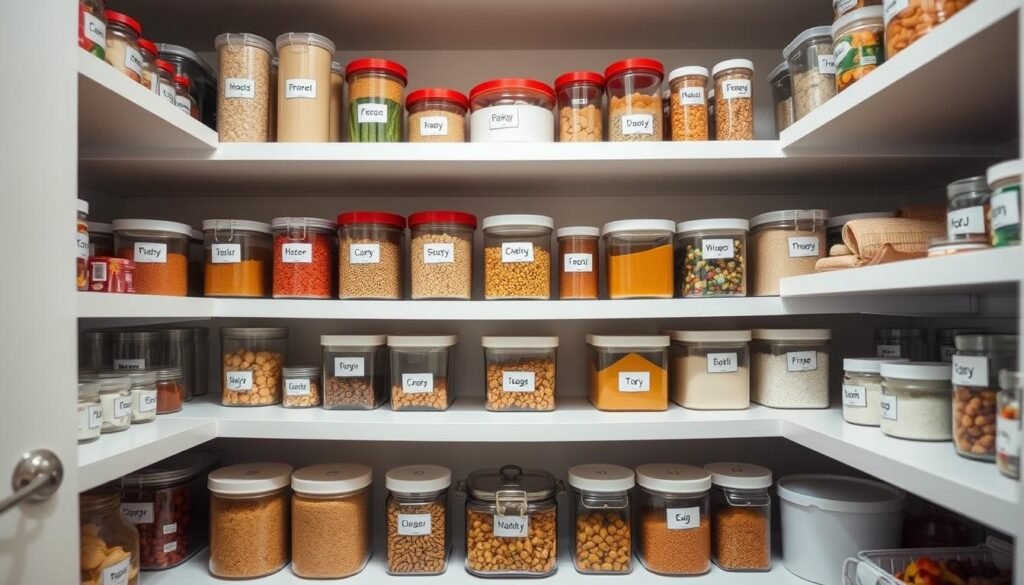
The right labeling system can transform your pantry from chaotic to controlled. A good labeling system is not just about slapping labels on containers; it’s about creating a system that enhances your kitchen’s functionality and makes meal prep a breeze.
Label Types and Materials
When it comes to labeling your pantry, you’ve got options. You can go for simple handwritten labels, or you can opt for custom printed or chalkboard labels. The key is to choose a method that fits your style and needs. For durability, consider using waterproof and oil-resistant materials that can withstand the kitchen environment.
What to Label (and What Not To)
Not everything needs a label, but certain items benefit greatly from them. Similar-looking ingredients, like different types of flour or sugar, should always be labeled to avoid confusion. It’s also a good idea to label items with expiration dates so you can keep track of what needs to be used first. On the other hand, items that are clearly identifiable, like a bag of apples, don’t need a label.
Creating a System Everyone Can Follow
To create a labeling system that’s intuitive for everyone in the household, consider using a standardized format that includes the item name, expiration date, and any relevant cooking instructions. This will make it easy for anyone to navigate your pantry. Additionally, placing labels in a consistent location on containers can help create a visual routine.
By implementing a thoughtful labeling system, you’ll not only maintain your pantry’s organization but also reduce food waste by making expiration dates visible and ingredients identifiable. With a little creativity, your pantry can become a model of efficiency and ease.
Small Pantry Solutions: Making Minimal Space Work
Small pantries can be a real challenge, but with the right strategies, you can make the most of the space you have. The key is to optimize every inch, from the shelves to the door and even the walls.
Maximizing Narrow Shelves
To make the most of narrow shelves, consider using slim containers that fit snugly on the shelf, allowing for easy access and visibility of your pantry staples. Strategic stacking is also crucial; place less frequently used items towards the back or on higher shelves.
Creative Solutions for Closet Pantries
For small pantry or closet pantry setups, utilizing the back of the door with over-the-door organizers or hooks can significantly increase your storage capacity. Custom shelf configurations can also help maximize the available space, ensuring that every item has its designated place.
When to Store Elsewhere
Not everything needs to be stored in your pantry space. Consider alternative storage locations in your kitchen for items that don’t fit or aren’t used frequently, such as special occasion dishes or infrequently used appliances. This helps maintain a clutter-free small pantry and ensures that your storage solutions are efficient and effective.
Regularly purging your pantry and managing inventory is essential to prevent overcrowding. Swapping bulky packaging for space-efficient containers can also help. By prioritizing what’s truly important to store in your pantry, you’ll be able to maintain a well-organized and functional kitchen space.
Conclusion: Maintaining Your Newly Organized Pantry
Now that you’ve transformed your pantry into an organized oasis, the real work begins: maintaining it. To keep your space organized, remember the key strategies we’ve covered, from decluttering and inventory management to smart storage solutions.
Maintaining your pantry organization is an ongoing process. Implement a “one in, one out” rule to prevent overcrowding and schedule quarterly check-ins to remove expired items. This will help you maximize pantry space efficiently.
A well-organized kitchen pantry not only saves time but also reduces food waste and makes cooking more enjoyable. Start small if you’re feeling overwhelmed, and don’t forget to get your family on board with the new system. The perfect organization system works for your specific needs and habits. Share your pantry organization successes or questions with us!
FAQ
How can I make the most of my pantry’s vertical storage?
To optimize your pantry’s vertical storage, consider installing shelves or storage units that go up to the ceiling. You can also use stackable containers or baskets to store dry goods, snacks, or other kitchen essentials.
What are some effective ways to store canned goods and other heavy items?
Store heavy items like canned goods on lower shelves or in easy-to-access baskets to prevent straining your back. You can also use a lazy Susan or turntable to make the most of corner shelves.
How can I keep my pantry organized and clutter-free?
To maintain a clutter-free pantry, establish a routine of regularly cleaning out expired or unused items, and use a labeling system to keep track of what’s inside containers or on shelves.
What are some creative storage solutions for small pantries or closets?
For small pantries, consider using over-the-door organizers, wall-mounted baskets, or slim storage units to make the most of available storage. You can also use clear containers or baskets to store items like snacks or baking supplies.
How can I make my pantry more kid-friendly?
To make your pantry more kid-friendly, consider using accessible storage solutions like low shelves or baskets, and label containers with pictures or simple text. You can also designate a specific area for snacks or kid-friendly foods.
What are some tips for organizing a walk-in pantry?
For a walk-in pantry, consider creating functional zones like a baking station or meal prep area, and use a mix of shelving, baskets, and containers to store a variety of kitchen essentials.
How often should I clean out my pantry?
It’s a good idea to clean out your pantry every 3-6 months to get rid of expired or unused items and keep your storage solutions organized.
